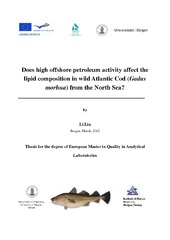| dc.description.abstract | A combined two step extraction, using hexane/methanol to extract neutral lipids and chloroform/methanol to extract polar lipids, has been developed and validation. Four times methanol wash were done to hexane/methanol extract and merged with chloroform/methanol extract to ensure optimized lipid classes distribution between two solvent systems. Quick freeze of hexane/methanol solvent system by dry ice was adopted to avoid adverse effect of generation of micelle. The glass aminopropyl bonded column was used to fractionate the lipid classes into: neutral lipids (NL), free fatty acids (FFA), phosphatidylcholine/phosphatidylethanolamine (PC/PE) and phosphatidylserine/phosphatidylinositol (PS/PI). The results show that 99% of neutral lipids were extracted into hexane while the chloroform/methanol remained 95 % of PC/PE and 88% of PS/PI. According to verification of thin-layer chromatography (TLC) and gas chromatography (GC) results, the solid phase extraction (SPE) separated the lipid classes effectively with good recoveries. The fatty acids profiles were compared with Folch extraction. There were some differences between these two methods. However, the two-step extraction showed very good repeatability and provided higher concentration of phospholipids in SPE eluates, which make it suitable for analysis of livers from wild Atlantic cod fish. Forty-three of wild Atlantic cod fish (Gadus morhua) were analyzed by the two-step extraction we proposed. The lipid distribution and fatty acid composition of different lipid classes were studied. High level of 22:1 n-11 was detected in neutral lipids as an indicator of diet. Higher amount of 18:1 n-9 and lower amount of 20:1 n-9 were found in phospholipids fractionated from samples in high offshore oil activity field. Lower level of n-3/n-6 ratio was also observed in PC/PE fraction. These observations support the hypothesis of altered fatty acid metabolism proposed by Balk et al.2. However, the evidences were limited by the small sample size and larger biological variance. The Principal Components Analysis (PCA) did not find obvious difference between samples collected in two areas. No effect of offshore petroleum activity on fatty acid composition in liver of Atlantic cod (Gadus morhua) can be concluded based on present study. | en_US |
